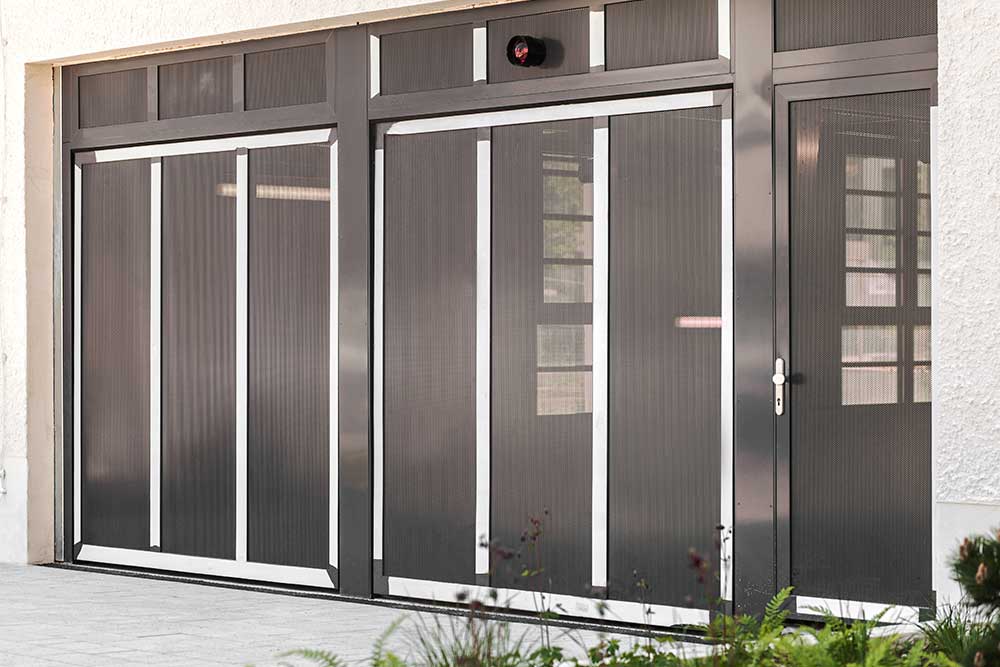In emergency situations, every second counts. The role of automatic door in emergency evacuations is critical, as they provide a swift and efficient means of escape for individuals in potentially life-threatening situations. Unlike traditional doors, which require manual operation, automatic door open automatically, allowing for a seamless flow of people during evacuations. These technologically advanced doors are equipped with sensors that detect motion, enabling them to open and close as needed. This not only facilitates the evacuation process but also helps prevent overcrowding and panic. Additionally, automatic doors comply with safety regulations to ensure they remain functional and accessible even during power outages. Whether it’s a fire, a natural disaster, or any other emergency, the presence of automatic door in public buildings, healthcare facilities, and commercial spaces significantly enhances safety protocols. Their ability to expedite the evacuation process can be a lifesaver, giving individuals a clear and unhindered path to safety. In conclusion, automatic door play a pivotal role in emergency evacuations, providing a reliable and efficient means of escape. Their smart technology and compliance with safety standards make them an invaluable asset in safeguarding lives during critical situations.
Importance of Quick and Safe Evacuations During Emergencies
During emergencies such as fires or earthquakes, every second counts. Automatic doors significantly reduce evacuation time by swiftly opening upon detection of emergency signals. This ensures that occupants can exit without delay, minimizing the risk of injury and enhancing overall safety.
- Swift Response to Emergency Signals: Automatic doors are equipped with sensors that detect emergency signals, such as alarms or alerts from the building’s fire or security systems. Upon detecting these signals, the doors automatically initiate their opening sequence without the need for manual intervention.
- Minimization of Evacuation Time: By swiftly opening in response to emergency signals, automatic doors create immediate pathways for occupants to exit the building. This reduces evacuation time significantly compared to manual doors, where delays in opening can occur due to human response times or the need to locate keys.
- Reduced Risk of Congestion and Panic: Automatic doors help maintain orderly evacuation procedures by providing clear and unobstructed exit routes. This clarity reduces the likelihood of congestion at exit points, preventing panic among occupants and ensuring a smoother evacuation process.
- Enhanced Safety for Occupants: The ability of automatic doors to open quickly and reliably contributes to the overall safety of building occupants. It ensures that everyone, including individuals with mobility challenges or those in distress, can exit the building promptly and safely.
- Compliance with Safety Standards: Many building codes and safety regulations now require the installation of automatic doors in certain types of buildings, especially those with high occupancy or specific safety considerations. These regulations aim to enhance overall building safety during emergencies.
How Automatic Door Enhance Emergency Evacuation Procedures
Automatic doors are designed to respond instantly to emergency signals, ensuring seamless operation even in high-stress situations. Their swift opening capabilities create clear evacuation routes, guiding individuals to safety with minimal confusion or obstruction.
- Instant Response to Emergency Signals: Automatic doors are equipped with sensors that detect emergency signals, such as fire alarms or security alerts. Upon receiving these signals, the doors activate immediately, initiating their opening sequence without any delay. This rapid response is critical in emergency situations where every second counts.
- Seamless Operation Under Stressful Conditions: During emergencies, such as fires or earthquakes, occupants may be in a heightened state of panic or urgency. Automatic doors are designed to operate reliably under these stressful conditions, ensuring that they open quickly and consistently to provide clear evacuation routes.
- Creation of Clear Evacuation Routes: Automatic doors help create unobstructed pathways for individuals to exit the building safely. Their swift opening capabilities minimize congestion and confusion at exit points, allowing occupants to evacuate efficiently without encountering barriers or delays.
- Accessibility for All Occupants: Automatic doors are particularly beneficial for ensuring accessibility during evacuations. They accommodate individuals with disabilities or mobility impairments by providing easy access to evacuation routes without the physical effort required to open traditional manual doors.
- Integration with Building Safety Systems: Modern automatic door systems are often integrated with the building’s overall safety infrastructure, including fire alarm systems and emergency lighting. This integration ensures synchronized operation, where doors open simultaneously with other safety measures, enhancing overall evacuation efficiency.
- Reduction of Human Error: Unlike manual doors that rely on occupants to physically open them, automatic doors operate autonomously based on preset protocols. This reduces the risk of human error during evacuations and ensures consistent performance regardless of the circumstances.
Types of Automatic Door Used in Emergency Evacuations
There are several types of automatic doors tailored for emergency scenarios, including sliding doors, revolving doors, and swing doors. Each type is selected based on the building’s layout, traffic flow, and specific emergency protocols to optimize evacuation efficiency.
- Sliding Doors: Sliding automatic doors are a popular choice for emergency exits due to their space-saving design and quick opening capabilities. These doors slide horizontally to open, providing wide clearance for rapid evacuation. They are often used in buildings with high traffic areas and where space is limited around the exit points.
- Revolving Doors: While not as common for primary emergency exits, revolving doors can play a role in controlled evacuations. In emergencies, these doors can be set to automatic mode or overridden to rotate freely, allowing a continuous flow of people out of the building. Revolving doors are advantageous in maintaining energy efficiency and preventing drafts, which can be crucial during fire evacuations.
- Swing Doors: Swing automatic doors operate similarly to traditional hinged doors but are equipped with automation for hands-free operation. They swing open either inward or outward based on the building’s layout and evacuation strategy. Swing doors are versatile and can be installed in various locations throughout a building, providing accessible exit points for occupants.
- Folding Doors: Folding automatic doors consist of multiple panels that fold and unfold as they open and close. They are suitable for areas with limited space where a traditional swinging or sliding door might not be practical. Folding doors can create wide openings quickly, making them effective for emergency exits in smaller or irregularly shaped spaces.
- Telescopic Doors: Telescopic automatic doors are designed with multiple overlapping panels that slide open and stack neatly to the side. They are ideal for locations where space is at a premium but require wider openings than standard sliding doors. Telescopic doors ensure efficient use of available space while allowing for swift evacuation during emergencies.
Features and Benefits of Automatic Door in Emergency Situations
Automatic doors are equipped with advanced features such as sensor technology, which detects changes in environment or movement. This enables doors to open automatically upon detecting emergency signals, ensuring immediate access to escape routes.
- Sensor Technology: Automatic doors are equipped with sensors that detect changes in the environment, such as smoke, heat, or movement. These sensors are integrated with the building’s fire alarm or security systems. Upon detecting emergency signals from these systems, the sensors trigger the automatic doors to open immediately. This swift response ensures that escape routes are quickly accessible to occupants, minimizing evacuation time and reducing the risk of injury.
- Hands-Free Operation: During emergencies, occupants may be carrying personal belongings or assisting others, making hands-free operation crucial. Automatic doors open without requiring physical contact, allowing occupants to move through them effortlessly. This feature is especially beneficial for individuals with disabilities or those carrying children or injured persons.
- Speed and Efficiency: Automatic doors open quickly and smoothly, creating clear evacuation routes with minimal delay. In high-stress situations, such as fires or earthquakes, every second counts. The rapid response of automatic doors helps maintain a steady flow of evacuating occupants, preventing congestion and ensuring orderly egress from the building.
- Reliability and Consistency: Automatic doors are designed for reliability, operating consistently under various conditions, including power outages or adverse weather. This reliability ensures that doors remain functional during emergencies when their operation is most critical. Additionally, regular maintenance and testing further enhance their reliability, verifying their responsiveness to emergency signals.
- Integration with Building Systems: Modern automatic door systems are often integrated with the building’s overall safety infrastructure, including fire alarm and emergency lighting systems. This integration ensures synchronized operation, where doors open simultaneously with other safety measures, such as exit signs illuminating and alarms sounding. Such coordinated responses enhance overall evacuation efficiency and effectiveness.
- Compliance with Safety Standards: Automatic doors comply with stringent safety standards and building codes, ensuring they meet specific requirements for emergency exits. These standards focus on accessibility, reliability, and durability to support safe egress during emergencies while adhering to regulatory guidelines.
Regulations and Guidelines for Installing Automatic Door in Emergency Exits
To ensure optimal functionality and compliance with safety standards, regulations dictate the installation and maintenance of automatic doors in emergency exits. These guidelines emphasize reliability, accessibility, and durability to support effective emergency response strategies.
- Building Codes and Standards: Various building codes and standards, such as those set by local authorities or national building regulations, outline specific requirements for the installation of automatic doors in emergency exits. These regulations ensure that automatic doors meet minimum safety and accessibility standards to facilitate efficient egress during emergencies.
- Accessibility Requirements: Automatic doors installed in emergency exits must comply with accessibility standards to accommodate individuals with disabilities or mobility impairments. This includes provisions for door width, clearance, and the ease of operation to ensure that all building occupants can evacuate safely and independently.
- Reliability and Durability: Regulations emphasize the reliability and durability of automatic doors in emergency situations. Doors must operate consistently and withstand high-stress conditions, such as fire or severe weather, without compromising their functionality. Regular maintenance and testing protocols are often mandated to verify the doors’ operational integrity and responsiveness to emergency signals.
- Emergency Response Integration: Automatic doors should be integrated with the building’s overall emergency response systems, including fire alarms and emergency lighting. This integration ensures synchronized operation, where doors open automatically in response to emergency signals, enhancing evacuation efficiency and safety.
- Clear Exit Signage and Visibility: Regulations may require clear signage indicating the presence of automatic doors in emergency exits. This signage helps occupants locate exit routes quickly during emergencies and ensures that the doors are easily identifiable and accessible under stress.
- Training and Awareness: Building occupants and personnel should receive training on the proper use and operation of automatic doors during evacuations. This training ensures that individuals understand how to navigate through automatic doors safely and efficiently in emergency situations, reducing the risk of confusion or delay.
- Compliance Verification: Authorities or building inspectors often conduct inspections to verify that automatic doors in emergency exits comply with regulatory requirements. These inspections ensure that installations meet safety standards and that maintenance practices adhere to prescribed guidelines to maintain door functionality.
Maintenance and Testing of Automatic Doors for Emergency Scenarios
Regular maintenance and testing are essential to ensure that automatic doors operate flawlessly during emergencies. Routine inspections and functional tests verify responsiveness to emergency signals, guaranteeing readiness when evacuation is necessary.
- Ensuring Operational Integrity: Automatic doors must operate reliably and swiftly during emergencies to facilitate safe and efficient evacuations. Regular maintenance involves inspecting door components, such as sensors, actuators, and control systems, to ensure they are in optimal condition. Any signs of wear, malfunction, or damage can be addressed promptly to prevent operational failures during critical moments.
- Verification of Emergency Response: Functional tests are conducted to verify that automatic doors respond appropriately to emergency signals, such as fire alarms or security alerts. These tests simulate emergency conditions to ensure that doors open promptly and fully, providing clear evacuation routes without delay or obstruction. Testing also includes checking the integration of automatic doors with the building’s overall emergency systems to confirm synchronized operation.
- Compliance with Safety Standards: Maintenance and testing activities align with safety standards and regulatory requirements governing the operation of automatic doors in emergency exits. These standards mandate periodic inspections and functional checks to uphold safety protocols and ensure that doors meet performance criteria for emergency scenarios.
- Preventive Maintenance Practices: In addition to performing reactive maintenance, we implement preventive maintenance practices to proactively identify and address potential issues before they escalate. This includes lubricating moving parts, adjusting sensors for optimal detection, and replacing worn-out components to maintain door reliability over time.
- Documentation and Record-Keeping: Maintenance activities are documented to track inspection schedules, test results, and any maintenance interventions performed. This documentation serves as a record of compliance with regulatory requirements and provides a historical reference for monitoring door performance and maintenance history.
- Training and Awareness: Maintenance personnel and building staff should receive training on the proper maintenance procedures and testing protocols for automatic doors. This training ensures that individuals understand their roles in maintaining door functionality and responding effectively during emergency situations.
- Emergency Preparedness: Regular maintenance and testing contribute to overall emergency preparedness by enhancing the reliability of automatic doors as critical components of evacuation routes. By ensuring doors are operational and responsive, building managers and safety officials can mitigate risks and optimize evacuation procedures during emergencies.
Training and Awareness for Using Automatic Doors During Evacuations
Proper training enhances awareness among occupants regarding the use of automatic doors during evacuations. Educational programs and drills familiarize individuals with emergency procedures, ensuring they understand how to navigate through automatic door safely and efficiently.
- Familiarity with Operation: Many building occupants may not be familiar with automatic door or their operation during normal circumstances, let alone during emergencies. Training programs educate individuals on how automatic door function, including their automatic opening mechanisms and the presence of sensors that detect emergency signals. This familiarity ensures that occupants can confidently use these doors when evacuating under stressful conditions.
- Understanding Emergency Procedures: Training sessions outline specific emergency procedures that include the use of automatic door. Occupants learn the importance of promptly responding to alarms or alerts, moving toward designated exit routes, and safely passing through automatic door to reach safety zones outside the building. This understanding reduces confusion and panic during actual emergencies, promoting orderly evacuations.
- Hands-On Drills and Simulations: Educational programs often include hands-on drills and simulations that simulate emergency scenarios. These drills allow occupants to practice navigating through automatic door under controlled conditions, reinforcing their understanding of evacuation routes and procedures. Practical experience during drills builds confidence and ensures that individuals can react effectively when faced with real emergencies.
- Accessibility Considerations: Training addresses the accessibility features of automatic door, ensuring that individuals with disabilities or mobility impairments understand how to utilize these doors during evacuations. This includes information on door width, clearance requirements, and the availability of accessible routes to ensure that all occupants can evacuate safely and independently.
- Coordination with Building Safety Systems: Occupants understand how automatic doors integrate with the building’s overall safety systems, such as fire alarms and emergency lighting. Training emphasizes the synchronized operation of these systems, ensuring that automatic door open simultaneously with other safety measures to facilitate swift egress from the building.
- Role of Building Personnel: Training sessions may also include instructions for building personnel responsible for overseeing and maintaining automatic door. Personnel regularly check door functionality, promptly respond to maintenance issues, and assist occupants during evacuations if necessary.
- Continuous Improvement: We periodically review and update training programs to incorporate lessons learned from past incidents or changes in building configurations. This ongoing education ensures that occupants remain informed about the latest safety protocols and technologies related to automatic door and emergency evacuations.
Conclusion: The Future of Automatic Doors in Emergency Evacuations
Looking ahead, the integration of automatic door continues to evolve, with advancements in technology enhancing their role in emergency preparedness. As buildings become smarter and more connected, automatic door will play an increasingly integral part in safeguarding lives during emergencies.
For personalized glass solutions that exceed expectations, Glass World can be your trusted partner. Get in touch with us today to explore our extensive range and find the ideal glass products for your projects.


